Cones and colour definicies
1/31
There's no tags or description
Looks like no tags are added yet.
Name | Mastery | Learn | Test | Matching | Spaced |
|---|
No study sessions yet.
32 Terms
Single Cone Sensitivity
Imagine you have only one type of cone in your eye.
This cone is most sensitive to 550 nm light (which is green).
It also responds to other wavelengths (like red), but less strongly.
If we had one cone that is sensitive to green only
If 1000 photons of green light (550 nm) hit the cone:
→ Cone responds strongly = 100 response intensitySince the cone is most sensitive to green, you get a big response.
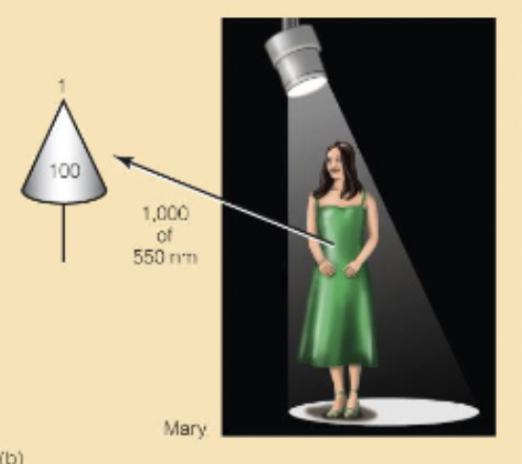
If we had one cone that is sensitive to green only if the cone perceives a red dress instead
If 1000 photons of red light (590 nm) hit the cone:
→ Cone responds weakly = 50 response intensityThe cone is less sensitive to red, so the response is weaker.
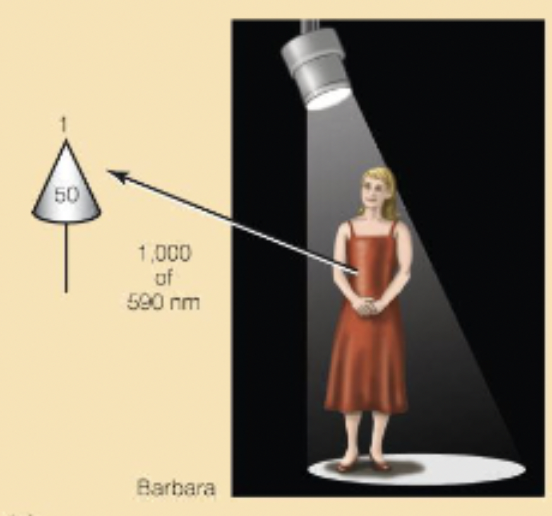
What if we increased the brightness of the red light
If you increase the brightness of the red light (e.g., 2000 photons):
→ Cone response increases to 100 (same as dim green).Now dim green and bright red give the same response → confusing!

In this case we now have the same amount of activation coming from the brightred and dim green
Principle of univariance
A photoreceptor can only signal the amount of light absorbed, not the wavelength. Once a photon is absorbed, the receptor responds the same way regardless of the light's wavelength.
Monochromat
A monochromat has only one functioning cone type — or none at all.
They need only one wavelength to match any perceived color.
How Monochromats Perceive Color
Monochromats can’t tell the difference between colors.
They can only tell the difference based on intensity (brightness).
Example: A bright red and a dim green may look the same because the response intensity is similar.
its kind of like our dark adapted vision where at night we cant see differences between colours, but we can see what is more intense.
Types of Monochromacy
Green Cone Monochromats – Only green cones work.
Rod Monochromats – No functioning cones, only rods work → Total color blindness.
Cones in seals
Some whales and seals lack S cones (blue) and L cones (red).
They are likely green cone monochromats — they only have functional green cones.
What if we only had two cone types?
ex)
Cone 1 – Most sensitive to 550 nm (green).
Cone 2 – Most sensitive to shorter wavelengths (like blue).
This allows the brain to compare the ratio of activation between the two cones.
What if we showed the person with 2 cones a green light?
If green light (550 nm) hits the cones:
Cone 1 (green) responds strongly.
Cone 2 responds weakly (because it’s less sensitive to longer green wavelengths).
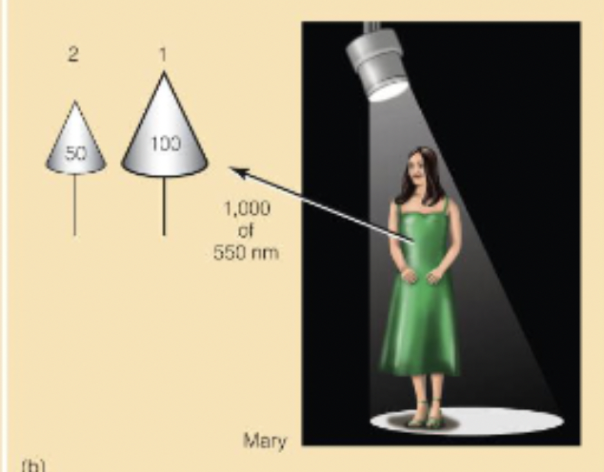
What if we showed the person with 2 cones a red light?
Cone 1 responds moderately.
Cone 2 responds weakly (since red is even farther from its peak sensitivity).
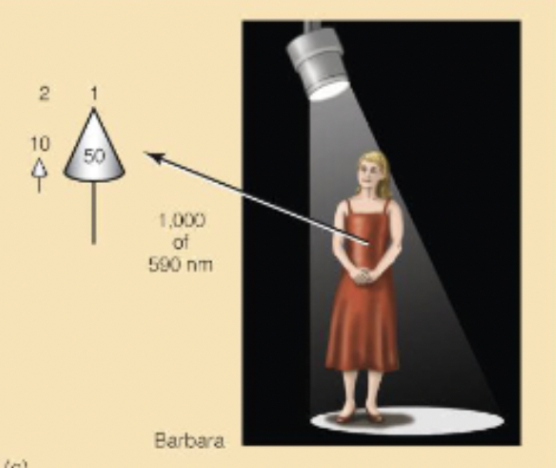
→ Cone 1 = 50
→ Cone 2 = 10
→ Ratio = 50:10 (or 5:1)
What if we showed the person with 2 cones a brighter red light?
If you double the intensity of red light (2000 photons):
Cone 1 = 100
Cone 2 = 20
Ratio = 100:20 → Still 5:1
Ratio stays the same even if brightness increases!
Why Ratio Solves the Problem of only having two cones
The brain uses the ratio between Cone 1 and Cone 2’s activation to tell color apart.
Even if brightness changes, the ratio remains stable — so the brain can detect a difference in color rather than just intensity.
person with 1 cone only vs 2 cones only
With one cone → Can't tell the difference between dim green and bright red.
With two cones → The ratio between cone responses solves the ambiguity and allows color vision!
Activation Problem with One Cone
A single cone’s activation depends on:
-The wavelength of the light (color)
- The intensity of the light (brightness)This means that two different wavelengths (colors) can cause the same response if the intensity is adjusted — creating ambiguity.
Having two cones are sufficient for solving this problem.
Why Three Cones Improve our perception better
Two cones give basic color vision, but some colors may still look similar.
Three types of cones allow for finer color distinctions:
Short (S) – sensitive to blue (~420 nm)
Medium (M) – sensitive to green (~530 nm)
Long (L) – sensitive to red (~560 nm)
Trichromats
normal colour humans
Dichromat
two functioning cone types
they only need two wavelengths of light to match any perceived colour. (if they were to do the colour beam experiment)
3 types of dichromats
Protanopia
Deutranopia
Tritanopia
Are males or females more liekly to be a dichromat
males (its x-linked)
How do we know what colours look like for people who are colourblind?
we can test people who are unilateral dichromats.
Unilateral dichromat
trichomatic vision in one eye and dichromatic in other
Dichromatism - Protanopia
Loss of detail for long wavelengths.
cant see red properly
neutral point=492
dichromats have neutral points
where colours start to look grey (because they are missing that wave)

Deuteranopia
Missing medium wavelength
cant see green properly
neutral point: 498
Tritanopia
missing short-wavelength pigment
neutral point → 570
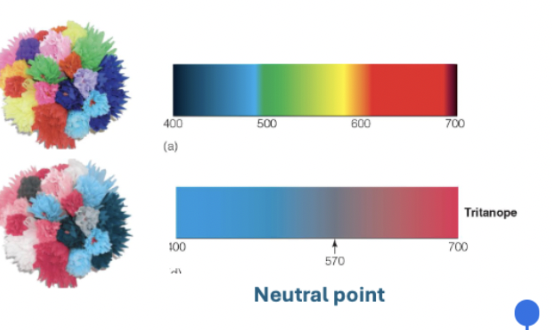
most rare and higher neutral point
Methods for diagnosing colour definciency
Colour-matching Procedure
Colour vision test
Colour-matching Procedure
determine minimum number of wavelengths needed to match any other wavelength (beams example)
Colour vision test
Farnsworth panel d-15 test
Ishihara plates
Farnsworth panel d-15 test
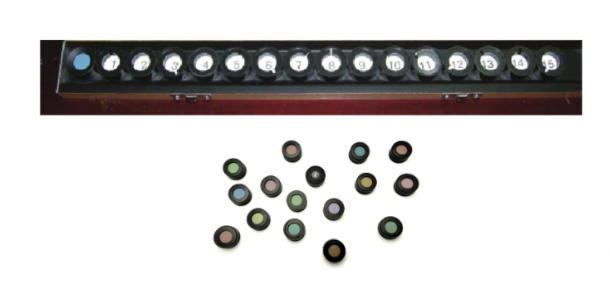
start with one colour and task is to arrange them into rainbow order

Someone who is missing a long wavelength cone can still divide between warm and cool colours but the details between each individual color is lost - we no longer have the clear gradation between blue to yellow.
Ishihara plates
They're used to diagnose red-green color blindness by checking whether a person can distinguish the numbers or shapes.
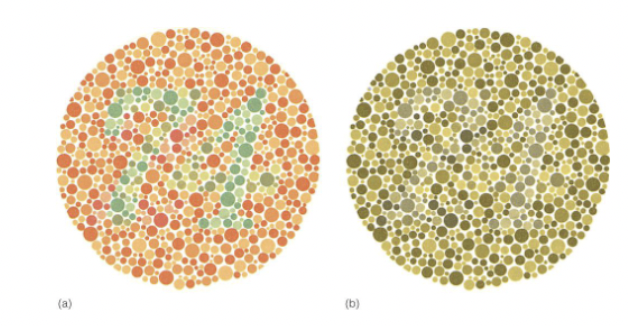
first is normal, second is someone with red-green colour blindness.